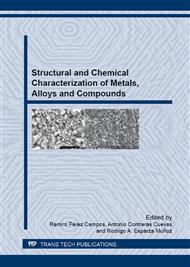[1]
Anil Kumar, H.M., Xu Zhang, Keyang Huang, Shubin Jin, Juan Liu, Tuo Wei, Weipeng Cao, Guozhang Zou, Xing-Jie Liang, Gold nanoparticles functionalized with therapeutic and targeted peptides for cancer treatment, Biomaterials 33 (2012) 1180-1189.
DOI: 10.1016/j.biomaterials.2011.10.058
Google Scholar
[2]
Y. Yang and S. Chen, Surface manipulation of the electronic energy of subnanometer-sized gold clusters: An electrochemical and spectroscopic investigation, Nano Lett. 3 (2003) 75-79.
DOI: 10.1021/nl025809j
Google Scholar
[3]
P.M. Tiwari, K. Vig, V.A. Dennis and S.R. Singh, Functionalized gold nanoparticles and their biomedical applications, Nanomaterials 1 (2011) 31-63.
DOI: 10.3390/nano1010031
Google Scholar
[4]
Chanel K. Yee, R.J., Abraham Ulman, Henry White, Alexander King, Miriam Rafailovich, and Jonathan Sokolov, Novel one-phase synthesis of thiol-functionalized gold, palladium, and iridium nanoparticles using superhydride, Langmuir 15 (1999).
DOI: 10.1021/la990015e
Google Scholar
[5]
Conklin, D., Plasmon Enhanced Photoconduction in Porphyringold Nanoparticle Assemblies (University of Pennsylvania, USA, 2011).
Google Scholar
[6]
S. Link and M. A. El-Sayed, Size and temperature dependence of the plasmon absorption of colloidal gold nanoparticles, J. Phys. Chem. B 103 (1999) 4212-4217.
DOI: 10.1021/jp984796o
Google Scholar
[7]
J. L. Zhang, R. S. Srivastava, R. D. K. Misra, Core-shell magnetite nanoparticles surface encapsulated with smart stimuli-responsive polymer: Synthesis, characterization, and LCST of viable drug-targeting delivery system, Langmuir 23 (2007).
DOI: 10.1021/la0636199
Google Scholar
[8]
D. Sutton, N. Nasongkla, E. Blanco and J. Gao, Functionalized Micellar Systems for Cancer Targeted Drug Delivery, Pharm. Res. 24 (2007) 1029-1046.
DOI: 10.1007/s11095-006-9223-y
Google Scholar
[9]
Yu-Feng Li and Chunying Chen, Fate and toxicity of metallic and metal-containing nanoparticles for biomedical applications, Small 7 (2011) 2965-2980.
DOI: 10.1002/smll.201101059
Google Scholar
[10]
A. Shakeri-Zadeh, G. Ali Mansoori, A. Reza Hashemian, H. Eshghi, A. Sazgarnia, A. Reza Montazerabadi, Cancerous cells targeting and destruction using folate conjugated gold nanoparticles, Dyn. Biochem. Process Biotech. Mol. Biol. 4 (2010) 6-12.
Google Scholar
[11]
V. G. Yarzhemsky and C. Battocchio, The structure of gold nanoparticles and Au based thiol self-organized monolayers, Russ. J. Inor. Chem. 56 (2011) 2147-2159.
DOI: 10.1134/s003602361114004x
Google Scholar
[12]
A. S. Thakor, J. Jokerst, C. Zavaleta, T. F. Massoud, and S. S. Gambhir, Gold nanoparticles: A revival in precious metal administration to patients, Nano Lett. 11 (2011) 4029-4036.
DOI: 10.1021/nl202559p
Google Scholar
[13]
P. C. Chen, S.C. M Mwakwari, and A. K Oyelere, Gold nanoparticles: From nanomedicine to nanosensing, Nanotechnology, Science and Applications 1 (2008) 45-66.
DOI: 10.2147/nsa.s3707
Google Scholar
[14]
D. A. Giljohann, D. S. Seferos, W. L. Daniel, M. D. Massich, P. C. Patel, and C. A. Mirkin, Gold nanoparticles for biology and medicine, Angew. Chem. Int. Ed. 49 (2010) 3280-3294.
DOI: 10.1002/anie.200904359
Google Scholar
[15]
P. K. Jain, K. Seok Lee, I. H. El-Sayed, and M. A. El-Sayed, Calculated absorption and scattering properties of gold nanoparticles of different size, shape, and composition: Applications in biological imaging and biomedicine, J. Phys. Chem. B 110 (2006).
DOI: 10.1021/jp057170o
Google Scholar
[16]
H. C. Huang, S. Barua, G. Sharma, S. K. Dey, K. Rege, Inorganic nanoparticles for cancer imaging and therapy, J. Control. Rel. Vol. 155 (2011) 344-357.
DOI: 10.1016/j.jconrel.2011.06.004
Google Scholar
[17]
Y. Pan, S. Neuss, A. Leifert, M. Fischler, F. Wen, U. Simon, G. Schmid, W. Brandau, and W. Jahnen-Dechent, Size-dependent cytotoxicity of gold nanoparticles, Small 3 (2007) 1941-1449.
DOI: 10.1002/smll.200700378
Google Scholar
[18]
I. Boustani, Systematic ab initio investigation of bare boron clusters: Determination of the geometry and electronic structures of Bn (n=52 – 14), Phys. Rev. B 55 (1997) 16426-16438.
DOI: 10.1103/physrevb.55.16426
Google Scholar


